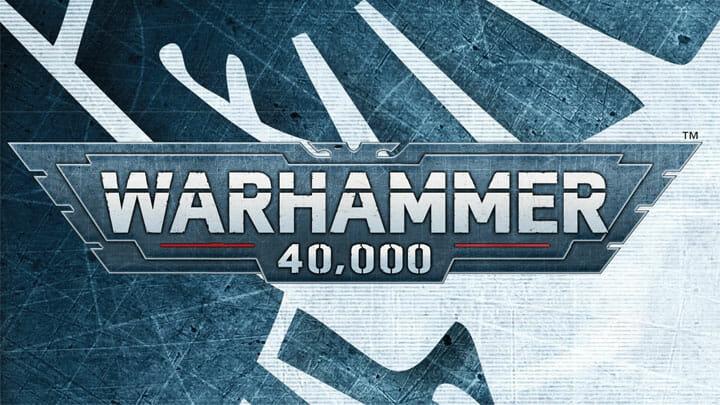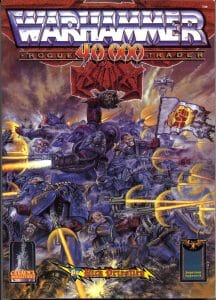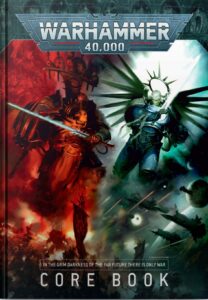Warhammer 40,000 has in the last 33 years, gone from being a tabletop wargame to be, in some ways, THE tabletop wargame (and much more besides).
Otherwise known as Warhammer 40k, the game is almost inescapable in its size, scope, and penetration – talk to any tabletop gamer and they’ll know the game and most likely will have played it too. However, all the Warhammer 40k players had to start somewhere and learn the basics of the game, so, in this article, we’re going to try and answer the almost impossible question: What is Warhammer 40,000?
We’re not going to go into deep detail about how to play a game of Warhammer 40k, we have other articles to cover that. This is a beginners guide to Warhammer 40k, so we’ll take an overview of a brief history, some key background lore, and some of the things that we love most about the game and the setting. So let’s don our power armour, pick up a bolter, and get to grips with Warhammer 40k 101.
The Beginnings
Warhammer 40,000 began in 1987 as a rule set for a narrative-styled tabletop game, with a game size intended at around 30 or 40 miniatures a side. Citadel Miniatures had been selling science-fiction based miniatures for a little while at this point and after the success of Warhammer Fantasy Battle in getting gamers to convert collections of miniatures intended for Dungeons and Dragons style RPGs into armies, they saw the opportunity to do the same with a Sci-fi range.
Subtitled “Rogue Trader”, the game was intended to be played with a Games Master / Umpire and the rules were very detailed. Quite early on, it was clear that the players really wanted to play battle games of two armies against each other, rather than the more cooperative style that Games Workshop had introduced. So, via expansions, supplements and so on, Rogue Trader morphed through the late 80s into a battle game of mighty Space Marines, downtrodden humans, their corrupted Chaos counterparts, and alien races (based on familiar fantasy tropes), in a nightmare universe of decay, oppression, and constant war.
The combination of the distinctive setting and the excellent miniatures (including some of Games Workshop’s first forays into plastic, multipart figures) turned the game into a huge hit from where it’s grown, and grown, and changed, while still holding true to its core values.
The Universe
Every edition of the Warhammer 40,000 rule book starts with a version of the same intro, a nightmarish Groundhog Day reflection of the opening crawl to a Star Wars movie. The wording changes a little from edition to edition, but the core points are the same:
- It’s the future. About 39,000 years in the future.
- There’s an emperor on earth, and he’s been there for ten thousand years. He’s pretty much dead.
- Things for his empire are not going well.
- Life in this universe is cheap, short, and pretty much as bad as you can imagine.
- There is only War.
Humanity, in this universe, is ruled by The Imperium of Man – a failing, sclerotic empire, headed by “The Emperor”, an unimaginably powerful psychic being, almost certainly immortal. He rose to power about ten thousand years ago, and set out into the stars to reclaim the lost colonies of mankind.
At the moment of final victory, he found half his forces had turned against him, creating a bloody civil war which mostly destroyed him and ended the secular utopia (your mileage may vary) he planned to build. The Imperium is now a totalitarian, religious dictatorship which makes Stalinist Russia seem like a vicar’s picnic. And these are “the good guys”.
Set against humanity are hordes of aliens, all with their own rich histories and agendas. Some are impossibly ancient, powerful, and cunning. Some are coming in from outside the galaxy to eat everything. Some are up and coming new races. Some are impossibly ancient, powerful, and some just want a fight. All see humanity as a target for destruction, vengeance, or lunch.
And if that wasn’t bad enough, there’s also Chaos – those forces, real and supernatural, that fight in the service of ancient “Gods” that dwell in the nightmare dream dimension known as the Warp. It was these gods that corrupted the Imperial forces ten thousand years ago and shattered the fledgling imperium in a schism known as The Horus Heresy. Expect to meet these forces if you’ve got a dinner date on a distant planet as faster-than-light speeds require you to travel through the Warp. We can only imagine it’s akin to riding Nemesis or Kingda Ka – a cocktail of exhilaration and underpant soiling fear.
These four gods each represent a concept of mortal weakness. Khorne is the god of violence and slaughter. Tzeentch the god of sorcery and scheming. Slaanesh the god of pleasure and excess. And finally there’s Nurgle, the god of pestilence and decay. Each seeks to invade and corrupt the physical world, and each is in a state of constant scheming and rivalry with the others.
One of the joys of Warhammer 40k is that every sentence of the above is an attempt to summarise a deep, rich lore that’s been built up over the last 33 years. This means that when you come to choosing a force to play the game with, it has it’s own vast and detailed history of its triumphs, defeats, heroes, and villains.
That seems like a good place to take a break and draw a line under our Beginner’s Guide To Warhammer 40,000. Go make a cup of tea, crack open those milk chocolate digestives (the only biscuit worthy of a dunk) and then click here to continue our Warhammer 40k overview.


